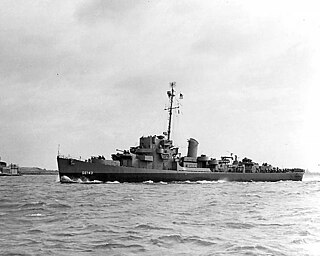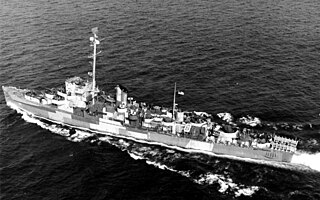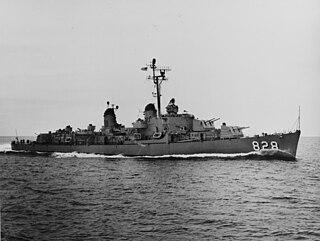Two ships of the United States Navy have borne the name USS Fiske, in honor of Rear Admiral Bradley A. Fiske.

The United States Navy (USN) is the naval warfare service branch of the United States Armed Forces and one of the seven uniformed services of the United States. It is the largest and most capable navy in the world and it has been estimated that in terms of tonnage of its active battle fleet alone, it is larger than the next 13 navies combined, which includes 11 U.S. allies or partner nations. with the highest combined battle fleet tonnage and the world's largest aircraft carrier fleet, with eleven in service, and two new carriers under construction. With 319,421 personnel on active duty and 99,616 in the Ready Reserve, the Navy is the third largest of the service branches. It has 282 deployable combat vessels and more than 3,700 operational aircraft as of March 2018, making it the second largest and second most powerful air force in the world.

Rear Admiral Bradley Allen Fiske was an officer in the United States Navy who was noted as a technical innovator. During his long career, Fiske invented more than a hundred and thirty electrical and mechanical devices, with both naval and civilian uses, and wrote extensively on technical and professional issues; The New Yorker called him "one of the notable naval inventors of all time." One of the earliest to understand the revolutionary possibilities of naval aviation, he wrote a number of books of important effect in gaining a wider understanding of the modern Navy by the public. For inventing the rangefinder, he was awarded the Elliott Cresson Medal of The Franklin Institute in 1891.
- The first USS Fiske (DE-143), was an Edsall-class destroyer escort, launched in 1943 and sunk by a U-boat in 1944
- The second USS Fiske (DD-842), was a Gearing-class destroyer, launched in 1945 and struck in 1987. She was transferred to Turkey in 1981 and served as TCG Piyalepasa (D350) until she was scrapped in 1999

USS Fiske (DE-143) was an Edsall-class destroyer escort built for the United States Navy during World War II. Named for Rear Admiral Bradley Allen Fiske, she was the first of two U.S. Naval vessels to bear the name. The vessel entered service in 1943 and served in the Atlantic Ocean during World War II as part of a hunter-killer anti-submarine group. On 2 August 1944, Fiske was sunk by a torpedo fired by the German submarine U-804. Thirty-three of the ship's crew were killed and a further 50 were injured.

The Edsall-class destroyer escorts were destroyer escorts built primarily for ocean antisubmarine escort service during World War II. The lead ship, USS Edsall, was commissioned on 10 April 1943 at Orange, Texas. The class was also known as the FMR type from their Fairbanks-Morse reduction-geared diesel drive, with a type of engine used in the submarines of the time. The FMR's substitution for a diesel-electric power plant was the essential difference from the predecessor Cannon ("DET") class. This was the only World War II destroyer escort class in which all the ships originally ordered were completed as United States Navy destroyer escorts. Destroyer escorts were regular companions escorting the vulnerable cargo ships. Late in the war, plans were made to replace the 3-inch (76 mm) guns with 5-inch (127 mm) guns, but only Camp was refitted. In total, all 85 were completed by two shipbuilding companies: Consolidated Steel Corporation, Orange, Texas (47), and Brown Shipbuilding, Houston, Texas (38). Most were en route to the Pacific Theater when Japan surrendered. One of the ships participated in Operation Dragoon and two were attacked by German guided missiles.

Destroyer escort (DE) was the United States Navy mid-20th-century classification for a 20-knot (23 mph) warship designed with endurance to escort mid-ocean convoys of merchant marine ships. Kaibōkan were designed for a similar role in the Imperial Japanese Navy. The Royal Navy and Commonwealth forces identified such warships as frigates, and that classification was widely accepted when the United States redesignated destroyer escorts as frigates (FF) in 1975. Destroyer escorts, frigates, and kaibōkan were mass-produced for World War II as a less expensive antisubmarine warfare alternative to fleet destroyers. Other similar warships include the 10 Kriegsmarine escort ships of the F-class and the two Amiral Murgescu-class vessels of the Romanian Navy.
| This article includes a list of ships with the same or similar names. If an internal link for a specific ship led you here, you may wish to change the link to point directly to the intended ship article, if one exists. |












